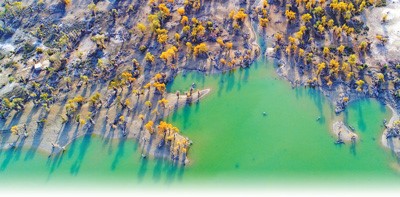China revives desert forests with diverted floodwater
"Look! A goshawk!" exclaimed Dilshat Manglik, a forest ranger in northwest China's Xinjiang Uygur Autonomous Region. Pointing to the bird circling above a desert poplar forest, he added, "We've been spotting them often during our riverbank patrols lately. They're likely here hunting hares."
Dilshat Manglik explained that in the past, many desert poplar trees suffered from long-term water shortages. This caused their health to decline over time. As a result, plants struggled to grow properly, and wildlife left the area.

Photo shows a desert poplar forest along the Tarim River in northwest China's Xinjiang Uygur Autonomous Region. [Photo/Lyu Fangming]
"After floodwater was diverted to replenish the desert poplar forest, the trees are now visibly greener, and there are more wild animals and plants in the forest. Every time I see the water coming, I feel very excited," said the forest ranger, who works at a desert poplar forest management station in Luntai county, Bayingolin Mongolian Autonomous Prefecture, Xinjiang.
The floodwater that has revived the desert poplar trees is from the Tarim River in the region.
As the longest inland river in China, the Tarim River stretches 2,486 kilometers with a basin area of 1.02 million square kilometers, nurturing over 12 million people, or nearly half of Xinjiang's total population.
The Tarim River basin is home to nearly 17 million mu (1.13 million hectares) of natural desert poplar forests, which account for over 90 percent of the total area of natural desert poplar forests in China and serve as an important ecological barrier in the oasis of southern Xinjiang.
Science-based water management has improved the Tarim River's ecology. During flood season, water is diverted to replenish desert poplar forests. This has effectively enhanced the environment along the riverbanks.
Since 2000, Xinjiang has taken steps to help its desert poplar forests. The region has carried out 25 water transfers to the lower Tarim River. These transfers come from the Daxihaizi Reservoir, located at the river's end. Nearly 10 billion cubic meters of water have been released to replenish the desert poplar forests.
This year, the region plans to add 5.1 billion cubic meters of water to desert poplar forest areas along the Tarim River basin.
Floodwater irrigation has greatly improved Luntai county's desert poplar forests, according to Metreyim Kerim, head of the county's forestry and grassland bureau. Soil moisture in the forest area has increased by over 50 percent, and the average groundwater level has risen by nearly a meter, from 3.53 meters to 2.6 meters deep.
As the forests have regained their health, vegetation like tamarisk, camel thorn, saxaul and Chinese licorice has gradually recovered. Wildlife such as red deer, goitered gazelle, white stork and goshawk have also returned, Metreyim Kerim said.
The diverted floodwater has also transformed 70,000 mu of Luntai county's 110,000 mu of desertified land into grassland, he added.
Metreyim Kerim said the Tarim River once posed significant challenges for residents living along its banks during the flood season.
"In the past, when floods came, we had to mobilize resources for flood control," he said. Now, they prepare by clearing diversion channels before the floods arrive. This allows them to guide the water where it's needed most, benefiting the local ecosystem instead of causing damage.
Local authorities are working to make the most of flood diversion channels. They've brought in machinery to dig additional branch channels alongside the main ones. This network of interconnected waterways allows water to penetrate deep into the desert poplar forests.
Since 2019, workers have cleared 130 kilometers of channels in Luntai county's desert poplar forests. They've also built 56 water diversion dams, 13 water retention dams and 18 water level monitoring wells in relevant areas.
"When water is scarce, we close the gates to ensure agricultural supply. When floods come, we open them to irrigate the desert poplar forests," said Shen Jun, head of the Yingbazha management station of the Tarim River's trunk stream administration.
Yingbazha management station, located in Lunnan township, Luntai county, oversees over 190 kilometers of river channels with more than 20 water gates on both sides.
Shen said they determine flood diversion timing based on the river's water situation. He recalled that on Aug. 5 this year, when midstream flow reached the alert level of 650 cubic meters per second, they opened the gates to release excess water into the forests.
Luntai county is home to 830,000 mu of natural desert poplar forests. The forestry and grassland bureau uses county data on water resources to guide its efforts. They control water flow through multiple gates, precisely delivering water to areas that need it most.
This year's original irrigation plan aimed to water 150,000 mu of desert poplar forests using 48 million cubic meters of water. However, heavy rains have increased water flow from upstream. This may allow for irrigating 300,000 to 400,000 mu of forests instead.
As the Tarim River's flood season coincides with desert poplar seeding, researchers manually sowed seeds where trees have died, and seeds failed to germinate due to lack of water, according to Zhang Guangpeng, an assistant research fellow from the Xinjiang Institute of Ecology and Geography under the Chinese Academy of Sciences.
Zhang explained that after water passed through, the seeds naturally germinated.
"We've surveyed areas like Lop county and Moyu county upstream and found approximately eight to nine new desert poplar seedlings per 100 square meters," Zhang said.
Since 2019, the total volume of living desert poplar trees has grown by 697,800 cubic meters in areas receiving extra water, with an average height increase of 0.42 meters, said Zhang Mengjie, an official from Xinjiang's Protection Center for Non-Commercial Forests.
Zhang noted the number of seedlings in concentrated renewal areas ranges from 22 to 48 per mu.
























